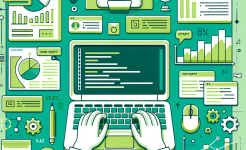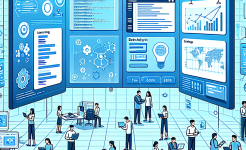Concept Development
Concept development is the initial and fundamental stage within the IPD R&D management system. It serves as the cornerstone upon which the entire product development journey is built. During this phase, cross-functional teams come together to explore market opportunities, understand customer needs, and generate innovative product concepts. This involves conducting in-depth market research, analyzing industry trends, and engaging with customers directly to gather insights. By doing so, teams can identify unmet needs and translate them into viable product ideas.
Once potential concepts are identified, they are further refined and evaluated. This includes assessing the technical feasibility, economic viability, and strategic alignment of each concept. Teams need to consider factors such as available technologies, manufacturing capabilities, and cost structures. Through rigorous evaluation, the most promising concepts are selected for further development. This process not only helps in focusing resources on the most viable ideas but also ensures that the final product will meet market demands and achieve business goals.
Moreover, concept development also fosters creativity and collaboration within the team. Different perspectives from various functions like marketing, engineering, and design are brought to the table, leading to the generation of diverse and innovative ideas. This collaborative environment encourages the exploration of new possibilities and helps in creating products that stand out in the market.
System Design
System design is a critical process that bridges the gap between the concept and the actual product. It involves defining the overall architecture and structure of the product, as well as the interfaces and interactions between its various components. In this stage, the focus is on creating a holistic design that meets the product requirements while considering factors such as performance, reliability, and maintainability.
The system design process begins with a detailed analysis of the product requirements. This includes understanding the functional and non-functional requirements, such as speed, accuracy, and user interface design. Based on this analysis, the team develops a high-level system architecture that outlines the major components and subsystems of the product. This architecture serves as a blueprint for the subsequent development phases.
Once the architecture is defined, the team proceeds to design the individual components and their interfaces. This requires careful consideration of factors such as compatibility, modularity, and scalability. By designing modular components, the product can be easily updated and enhanced in the future. Additionally, well-defined interfaces ensure seamless communication between different components, improving the overall performance of the product.
System design also involves conducting trade-off analyses. For example, the team may need to balance between performance and cost, or between functionality and ease of use. These trade-offs are crucial in ensuring that the final product meets the business objectives while satisfying customer needs.
Detailed Design
Detailed design takes the system design further by specifying the exact details of each component and subsystem. This process is highly technical and requires in-depth knowledge of the relevant engineering disciplines. In the detailed design phase, engineers create detailed drawings, specifications, and models of the product components.
For mechanical components, this may involve designing the shape, dimensions, and materials of the parts. Engineers need to consider factors such as strength, durability, and manufacturability. They use computer-aided design (CAD) tools to create precise 3D models of the components, which can be used for analysis and simulation.
In the case of electronic components, detailed design includes circuit design, component selection, and layout planning. Engineers need to ensure that the electronic circuits meet the required electrical specifications and are reliable. They also need to consider factors such as electromagnetic compatibility (EMC) and thermal management.
Software components also undergo detailed design. This involves defining the software architecture, algorithms, and data structures. Software engineers need to ensure that the software is efficient, scalable, and easy to maintain. They use design patterns and best practices to create high-quality software designs.

The detailed design phase also involves conducting reviews and validations. This helps in identifying and rectifying any potential issues early in the development process. By ensuring the accuracy and completeness of the detailed design, the subsequent development and manufacturing processes can proceed smoothly.
Product Development
Product development is the phase where the detailed design is translated into a physical product. This involves the actual manufacturing, assembly, and testing of the product. In this stage, the focus is on ensuring that the product meets the design specifications and quality standards.
Manufacturing begins with the procurement of raw materials and components. The manufacturing team needs to ensure that the materials and components are of high quality and meet the required specifications. They then use various manufacturing processes, such as machining, molding, and welding, to transform the raw materials into finished components.
Once the components are manufactured, they are assembled into the final product. This requires careful alignment and connection of the components to ensure proper functionality. Assembly processes need to be optimized to improve efficiency and reduce costs.
After assembly, the product undergoes rigorous testing. This includes functional testing, performance testing, reliability testing, and safety testing. The testing process helps in identifying any defects or issues in the product. Defects are then rectified, and the product is retested until it meets the required standards.
Product development also involves continuous improvement. Based on the test results and feedback from the manufacturing and quality control teams, the product design may be refined to improve its performance and quality. This iterative process ensures that the final product is of the highest possible quality.
Product Launch
Product launch is the final and crucial stage in the IPD R&D management system. It involves bringing the product to the market and ensuring its successful adoption by customers. This stage requires close collaboration between various functions, including marketing, sales, and customer support.
Marketing plays a key role in product launch. They develop marketing strategies to create awareness and generate interest in the product. This includes activities such as market research, branding, and advertising. Marketing teams need to understand the target market and position the product effectively to attract customers.
Sales teams are responsible for selling the product to customers. They need to be well-trained on the product features and benefits to effectively communicate with customers. Sales teams also need to build relationships with customers and provide excellent customer service to ensure customer satisfaction.
Customer support is essential during the product launch phase. They need to be prepared to handle customer inquiries, complaints, and technical issues. By providing prompt and effective customer support, the company can enhance customer loyalty and reputation.
Product launch also involves post-launch evaluation. The company needs to monitor the product's performance in the market, gather customer feedback, and make necessary improvements. This feedback loop helps in continuous product innovation and improvement, ensuring the long-term success of the product.
In conclusion, the five key processes under the IPD R&D management system - concept development, system design, detailed design, product development, and product launch - are integral to the successful development and launch of products. Each process builds on the previous one, with a clear focus on meeting customer needs, ensuring product quality, and achieving business goals. By following these processes in a systematic and integrated manner, companies can enhance their product development efficiency, reduce time-to-market, and gain a competitive edge in the market. The IPD R&D management system provides a framework that enables cross-functional teams to work together effectively, fostering innovation and collaboration throughout the product development lifecycle. This not only leads to the creation of high-quality products but also contributes to the long-term growth and success of the organization.
ARTICLE TITLE :Five key processes under the IPD R&D management system ,AUTHOR :ITpmlib

















